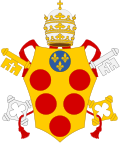
The list of popes from the Medici family includes four men from the late-15th century through the early-17th century. The House of Medici first attained wealth and political power in Florence in the 15th century through its success in commerce and banking. Its members were closely associated with the Renaissance and cultural and artistic revival during this period. [1]